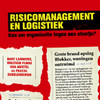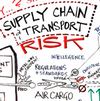 I am blessed to have a college library that complies with most of my book acquisition requests and the other day my library told me that the last book I asked them to acquire had arrived. It was the Harvard Business Review on Managing External Risk
I am blessed to have a college library that complies with most of my book acquisition requests and the other day my library told me that the last book I asked them to acquire had arrived. It was the Harvard Business Review on Managing External Risk, brand new, published in September 2009, part of the Harvard Business Review Paperback Series
. After flipping through the book my first feeling was general disappointment, perhaps because I am an academic, not a professional. After re-reading and re-considering I have to admit, though, that it wasn’t that bad after all. In fact, the book has managed to summarize the essence of executive risk management in an excellent manner. You don’t need to have an MBA to be enable to enjoy this book, common sense and curiosity about the inner workings of business decisions are enough. I learned a lot from this book.
Crème de la crème
The book consists of eight separate chapters, written by a selection of outstanding scholars and industry leaders, see the links below, where I have managed to find a personal or company website belonging to each of the authors (I didn’t find all, so if any of my readers want to help locate the rest, or if my links are wrong, please contact me).
Each chapter is equipped with an executive summary that can be read before the article, to see if this is something worth spending time on, or after the article, for summary and refreshing one’s memory. Excellent. There’s also a very brief bio of the contributors (which helped me in locating my links below) and a keyword index.
While supply chain risk per se is not a topic, financial risk and enterprise risk are. It is a lesson (actually several lessons) in how to embrace risk properly.
While preparing this post and doing some background research I also discovered a new term: agile risk management, but I think I will leave that for a later post, so let’s have a closer look at the chapters of this book.
One by one
The New Arsenal of Risk Management by Kevin Buehler, Andrew Freeman and Ron Hulme shows how risk management has evolved since the 1950s and in particular since the 1070s, in response to the changing business landscape. Goldman Sachs is used as a prime example for how a company can and should address risk and create a culture for risk: 1) quantitative professionals, 2) strong oversight, 3) partnership heritage, and 4) strong and enforced business principles.
A Letter to the Chief Executive by Joseph Fuller is a fictional letter from a board member to a CEO, highlighting the challenges and complexities of running a business today, seen in the light of the flaws that have recently emerged in the American management model, in particular the lack of conviction in settings one’s own course. A bit long and winding perhaps, but a good read.
Countering the Biggest Risk of All by Adrian J Slywotzky and John Drizik takes a closer look at strategic risks, and how companies can identify and respond to the seven strategic threats they see: 1) industry margin squeeze, 2) technology shift, 3) brand erosion, 4) competitor strategy changes, 5) customer preference shifts, 6) new project failures and 7) market stagnation. This chapter concludes with a brief step-by-step description of how to assess and manage risk.
A Framework for Risk Management by Kenneth A Froot, David S Sharfstein and Jeremy C Stein focuses on financial risk, in particular hedging strategies that rest on three pillars: 1) the key to creating corporate value is making good investments, 2) the key to making good investments is generating enough cash internally to fund them, 3) the key to having enough cash is to shield the cash flow from disruptions.
Disciplined Decisions: Aligning Strategy with the Financial Markets by Martha Amram and Nalin Kulatilaka is a primer on real options and how to use them, e.g. 1) timing options, 2) growth options, 3) staging options, 4) exit options, 5) flexibility options, 6) operating options and last, but not least, 7) learning options. Real options are complex and difficult to understand, but this chapter makes it look very easy.
Six Rules for Effective Forecasting by Paul Saffo demythologizes the forecasting process, so that executives can become sophisticated and participative consumers of forecasts, rather than passive absorbers, by first observing the wide range of possibilities and then narrowing down the decision space, by following six simple rules: 1) Define a cone of uncertainty, 2) Look for the S-curve, 3) Embrace the things that don’t fit, 4) Hold strong opinions weakly, 5) Look back twice as far as you look ahead, 6) Know when not to make a forecast. Brilliant.
Strategy Under Uncertainty by Hugh Courtney, Jane Kirkland and Patrick Viguerie outlines a new approach to decision making, based on four discrete levels of uncertainty a company might face: 1) Clear-enough future, 2) Alternate future, 3) A range of futures, and 4) True ambiguity. The chapter then proposes how to tailor the strategic analysis tools to fit the according uncertainty. Very interesting.
A Leader’s Framework for Decision Making by David J Snowden and Mary E Boone is very similar to the above, where leadership and decisions are sorted into five contexts: 1) Simple and stable – one answer (best practice) : “sense, categorize and respond”, 2) Complicated – multiple answers (expert judgement): “sense, analyze and respond”, 3) Complex – no real right answers (emerging solutions): “probe, sense, respond”, 4) Chaotic – no right answers, only patterns (rapid response): “sense where there is stability, transform from chaotic to complex”, and 5) Disorder – no apparent patterns (leadership across contexts): “break the whole into manageable contexts and act accordingly”. The best part about this chapter is the table that summarizes and compares these strategies.
Conclusion
This is a book for the industry, not for academia. It is written for C’-level executives and alikes. Nonetheless, even as a researcher I can relate to and utilize the ideas on risk management that are portrayed in this book. Unfortunately, however, for me as a researcher, there are no references. That does not make this book less valuable; as a researcher it it always interesting to know what the industry is concerned with in order to focus my research accordingly. To me, research has a value only only if it is practically applicable; there are plenty of problems that are academically intriguing but without relevance in real life. This book is real life, and while I am sure that it will inspire managers, it has also inspired me as a researcher in risk.
Reference
Harvard Business Review (2009). Managing External Risk. Boston: Harvard Business Press.
amazon.com
- Buy this book: Harvard Business Review on Managing External Risk
- See the whole series: Harvard Business Review Paperback Series
Related
- husdal.com: Book Review: Enterprise-wide risk management
- husdal.com: Rigorous risk management
- husdal.com: Risk as core competence











